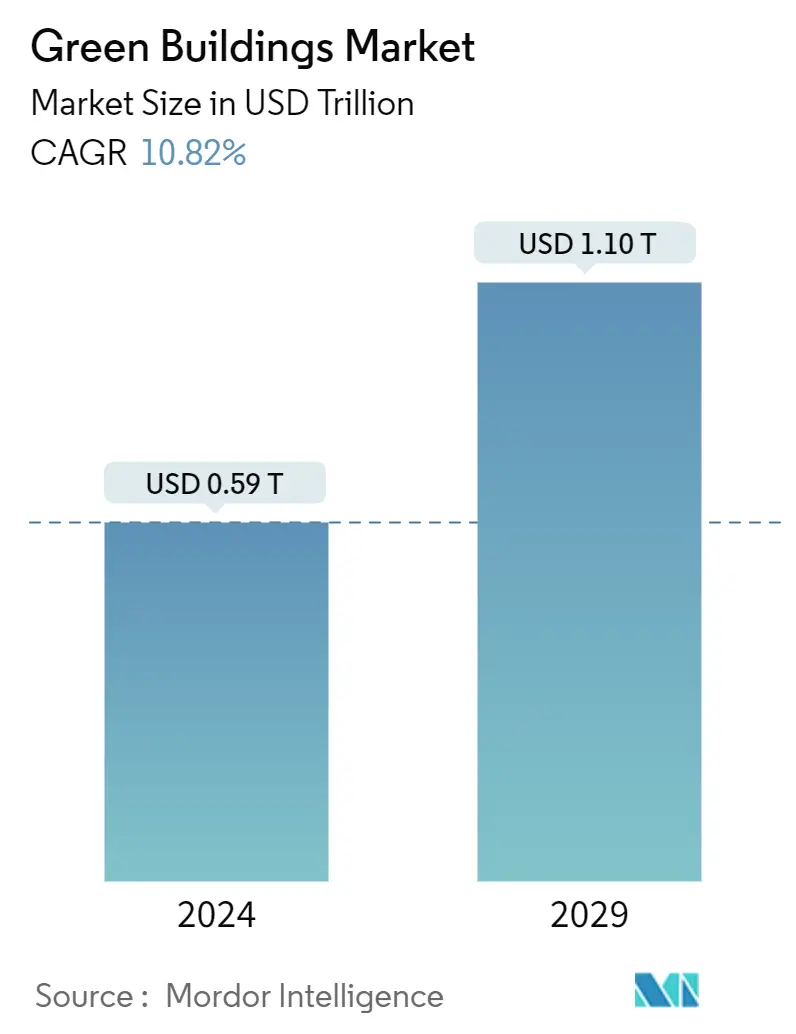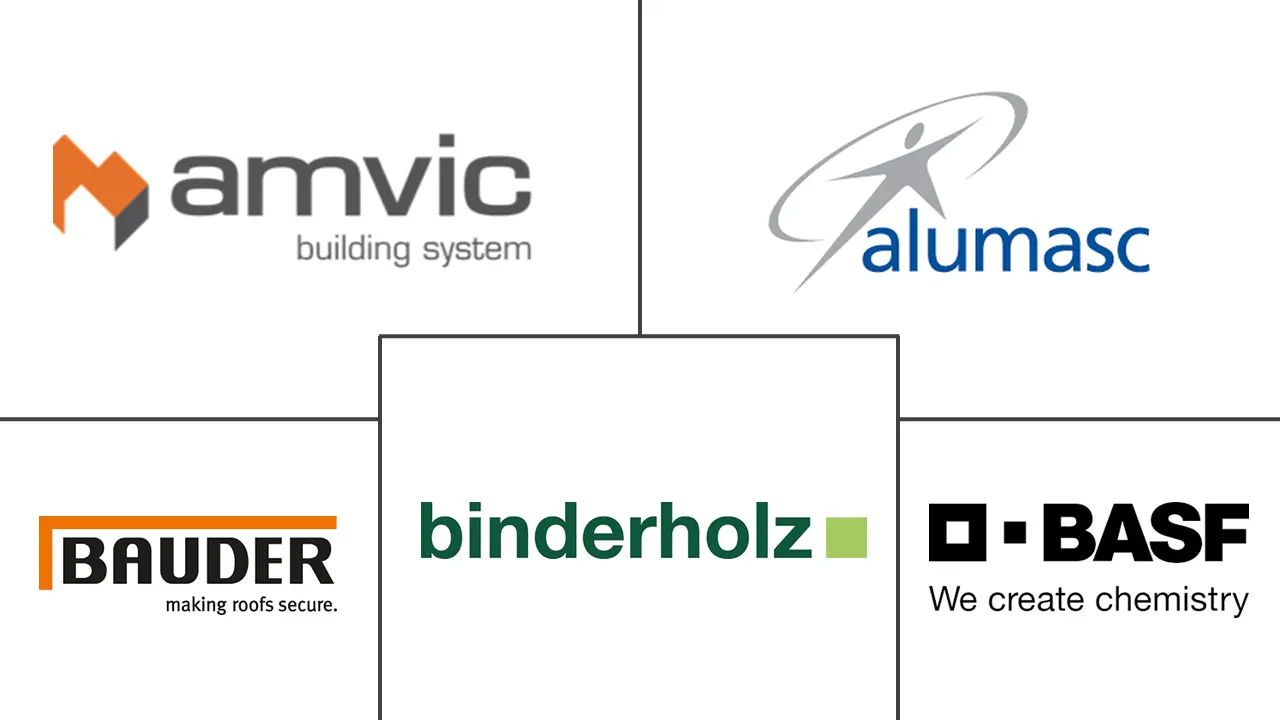Market Size of Green Buildings Industry

| Study Period | 2020-2029 |
| Market Size (2024) | USD 0.59 Trillion |
| Market Size (2029) | USD 1.10 Trillion |
| CAGR (2024 - 2029) | 10.82 % |
| Fastest Growing Market | Asia Pacific |
| Largest Market | Europe |
Major Players
*Disclaimer: Major Players sorted in no particular order |
Green Buildings Market Analysis
The Green Buildings Market size is estimated at USD 0.59 trillion in 2024, and is expected to reach USD 1.10 trillion by 2029, growing at a CAGR of 10.82% during the forecast period (2024-2029).
- The green buildings market refers to constructing and operating environmentally friendly and sustainable buildings. These buildings are designed to minimize their environmental impact, promote the health and well-being of occupants, and conserve resources.
- Green buildings incorporate various features and technologies such as energy-efficient lighting and HVAC systems, renewable energy sources like solar panels, efficient water management systems, recycled and sustainable materials, and improved indoor air quality.
- The market for green buildings has been growing rapidly in recent years due to increased awareness of environmental issues and the desire to reduce carbon emissions. Many countries have introduced policies and regulations to encourage the construction of green buildings, offering incentives and certifications such as LEED (Leadership in Energy and Environmental Design) or BREEAM (Building Research Establishment Environmental Assessment Method).
- The benefits of green buildings are numerous. They help reduce energy consumption, lower operating costs, decrease water usage, improve occupant comfort and productivity, and contribute to a healthier and more sustainable future.
- The green buildings market is not limited to commercial buildings but includes residential, educational, healthcare, and government buildings. It has become a global movement, with companies, organizations, and individuals actively adopting green building practices.
Green Buildings Industry Segmentation
The green building market is for buildings designed, built, and operated sustainably. This includes buildings with energy efficiency, renewable energy, water efficiency, waste reduction, and indoor environmental quality.
The green buildings market is segmented by product (exterior products, interior products, and other products ( building systems, solar systems, etc.)), by end user (residential, office, retail, institutional, and other end users), by geography (North America, Europe, Asia-pacific, Latin America, and Middle East and Africa). The report offers market size and forecasts for the green buildings market in value (USD) for all the above segments.
| By Product | |
| Exterior Products | |
| Interior products | |
| Other Products (Building Systems, Solar Systems, etc.) |
| By End User | |
| Residential | |
| Office | |
| Retail | |
| Institutional | |
| Other End Users |
| By Geography | |
| Asia-Pacific | |
| North America | |
| Europe | |
| South America | |
| Middle East and Africa |
Green Buildings Market Size Summary
The green buildings market is experiencing significant growth as the demand for environmentally friendly and sustainable construction practices increases globally. This market encompasses the design, construction, and operation of buildings that minimize environmental impact and promote occupant well-being. Key features of green buildings include energy-efficient systems, renewable energy sources, and the use of sustainable materials. The market's expansion is driven by heightened awareness of environmental issues, government policies, and incentives like LEED and BREEAM certifications. The benefits of green buildings are substantial, including reduced energy consumption, lower operating costs, and improved occupant comfort. This market is not limited to commercial structures but extends to residential, educational, healthcare, and government buildings, reflecting a global movement towards sustainability.
In the Asia-Pacific region, the green buildings market is poised for rapid growth due to government support, increasing environmental awareness, and a focus on energy efficiency. Countries like China, India, Japan, Singapore, and Australia are leading the charge with policies and initiatives promoting sustainable building practices. The region's urbanization and rising disposable income further drive demand for green buildings. The market is becoming increasingly competitive, with major players in the construction industry adopting sustainable design principles. Companies such as Amvik Systems, Alumasc Group PLC, BASF SE, Binderholz Gmbh, and Bauder Limited are key contributors to this market. Recent acquisitions and funding in the sector, like Accenture's acquisition of Green Domus and BlocPower's funding, highlight the growing emphasis on sustainability and energy efficiency in building practices.
Green Buildings Market Size - Table of Contents
-
1. MARKET INSIGHTS
-
1.1 Current Market Scenario
-
1.2 Technological Trends
-
1.3 Insights on Supply Chain/Value Chain Analysis of the Green Buildings Industry
-
1.4 Brief on Different Structures Used in the Prefabricated Buildings Industry
-
1.5 Cost Structure Analysis of the Green Buildings Industry
-
1.6 Impact of COVID 19
-
-
2. MARKET SEGMENTATION
-
2.1 By Product
-
2.1.1 Exterior Products
-
2.1.2 Interior products
-
2.1.3 Other Products (Building Systems, Solar Systems, etc.)
-
-
2.2 By End User
-
2.2.1 Residential
-
2.2.2 Office
-
2.2.3 Retail
-
2.2.4 Institutional
-
2.2.5 Other End Users
-
-
2.3 By Geography
-
2.3.1 Asia-Pacific
-
2.3.2 North America
-
2.3.3 Europe
-
2.3.4 South America
-
2.3.5 Middle East and Africa
-
-
Green Buildings Market Size FAQs
How big is the Green Buildings Market?
The Green Buildings Market size is expected to reach USD 0.59 trillion in 2024 and grow at a CAGR of 10.82% to reach USD 1.10 trillion by 2029.
What is the current Green Buildings Market size?
In 2024, the Green Buildings Market size is expected to reach USD 0.59 trillion.

